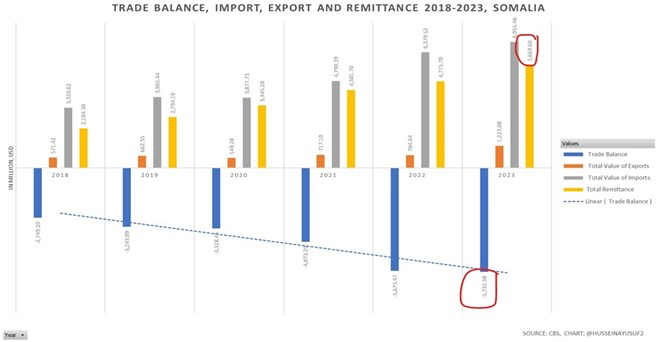Share the post "Somalia’s trade deficit widens, consuming total inward remittances as economic disparities grow.."
Somalis trade deficit has significantly widened over the past six years. In 2018, Somalia faced a trade deficit of USD 2.749 billion, which expanded to USD 5.7 billion by 2023. The total import value increased from USD 3.3 billion in 2018 to USD 6.955 billion in 2023, while the total export value grew from USD 571 million to USD 1.223 billion…
This trade imbalance has led to a substantial outflow of foreign currency that has adversely impacted local production capabilities as cheap imported goods flog the market, rendering domestic production in an uncompetitive position, Remittances constitute Somalia’s primary source of foreign exchange.
These inflows are primarily used to fund the country’s import bill, resulting in an outflow of U.S. dollars from domestic circulation to pay foreign exporters to Somalia. In 2023, remittance inflows totaled USD 5.6 billion, whereas the trade deficit was USD 5.7 billion. This data indicates that the entirety of the remittance inflows was directed towards settling the import bill, hence, the fund left the country with one 2023, without creating much long term value as depicted in the graph below, Purpose of the article is to explore the reasons behind the widening trade imbalance and suggest potential solutions.

Trade deficit is defined as when a country`s imports more goods and services than it exports, resulting in a negative balance of trade. The total import value in 2018 was USD 3.3 Billion while the total export value was USD 571 Million, leaving the country’s trade deficit of USD 2.749 Billion. Fast forward in 2023, the total import value was USD 6.955 Billion while total export value was at USD 1.223 Billion, leaving the country trade deficit of USD 5.732 Billion.
Political Instability: Somalia has experienced prolonged periods of conflict and instability, which have disrupted economic activities, including trade and investment. The lack of a stable government and infrastructure has made it difficult to manage and develop trade effectively.
Weak Infrastructure: Poor infrastructure, including inadequate road network, and communication systems, hinders trade by increasing transaction costs and reducing the efficiency of moving goods both within the country and across borders.
Limited Industrial Base: Somalia’s industrial sector is relatively under/not developed, leading to a heavy reliance on imports for manufactured goods and capital equipment. This lack of domestic production capacity contributes significantly to the trade deficit.
Dependence on Imports: The country relies heavily on imports for essential goods, including food, fuel, and machinery. This high dependency exacerbates the trade imbalance, as the value of imports often far exceeds that of exports.




